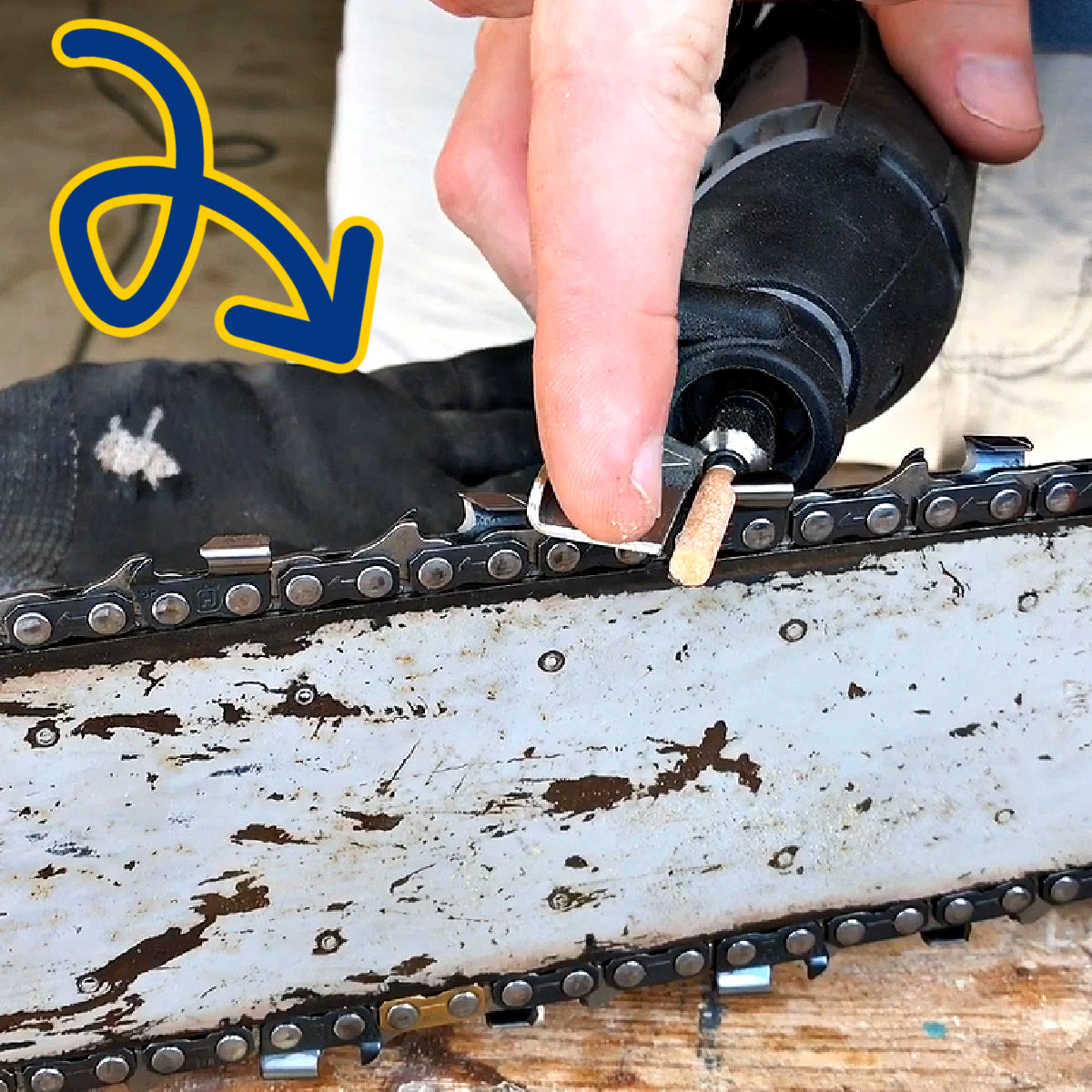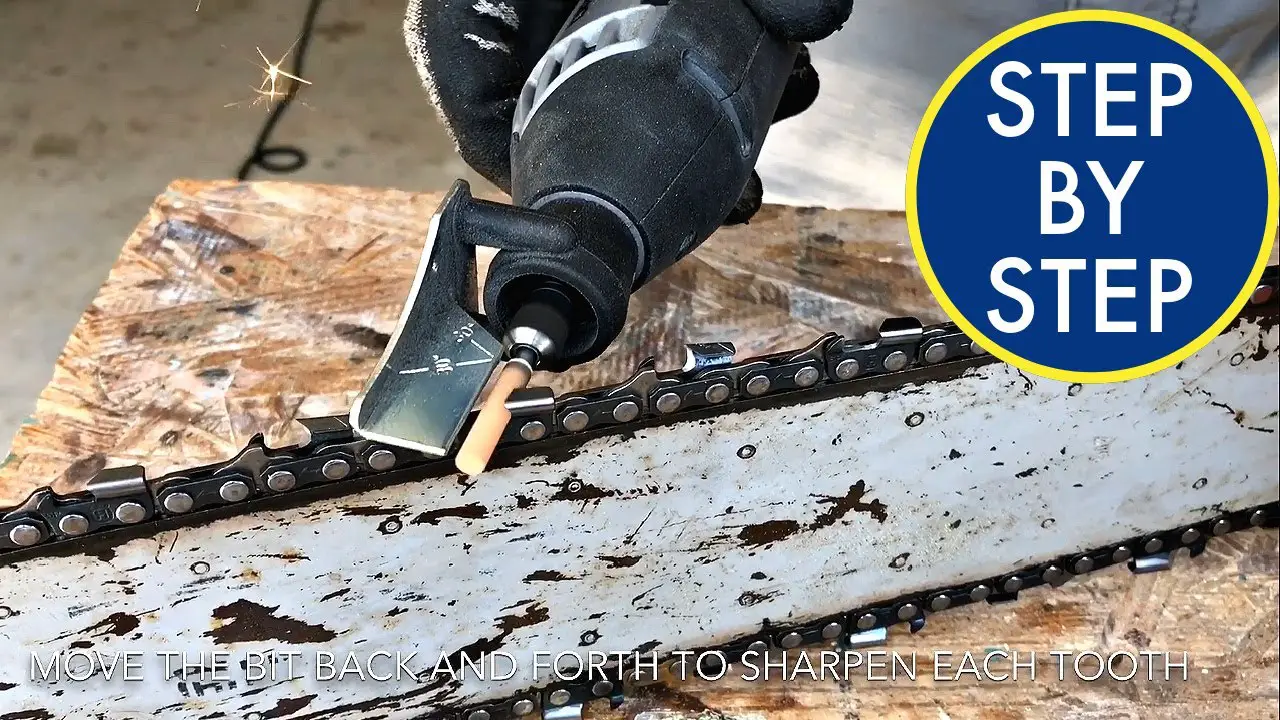To sharpen a chainsaw with a Dremel, attach the correct size sharpening stone and follow the chainsaw manufacturer’s recommended angle and depth specifications. Start by securing the chainsaw bar in a vice to keep it stable and safe.
Ensure the Dremel is set to the correct speed and gently glide the stone across the chain’s teeth, maintaining a consistent angle and pressure. Periodically check for a sharp edge, and repeat the process as needed until all teeth are sharpened evenly and effectively.
Remember to wear protective gear and follow all safety precautions throughout the sharpening process to avoid accidents. Properly maintaining your chainsaw blade ensures optimal performance and longevity.

Contents
- Introduction To Chainsaw Maintenance
- Essential Safety Precautions
- Identifying Dull Chainsaw Symptoms
- Selecting The Right Dremel Attachment
- Preparing Your Chainsaw
- Sharpening Process Step-by-step
- Checking Your Work
- Maintenance Tips For Longevity
- Troubleshooting Common Issues
- Maximizing Efficiency And Safety
- Frequently Asked Questions
- Conclusion
Introduction To Chainsaw Maintenance
Importance Of Sharp Chains
Sharp chains are crucial for efficient and safe chainsaw operation. Dull chains can lead to increased cutting time and dangerous kickback. Regular sharpening is essential to maintain optimal cutting performance and extend the lifespan of the chainsaw.
Role Of Dremels In Sharpening Tools
Dremel tools play a vital role in the maintenance of chainsaw chains. The precision and versatility of Dremels make them ideal for accurate and consistent sharpening of chainsaw blades. They allow for fine-tuning and sharpening of the individual cutting teeth, ensuring uniform cutting performance.
Essential Safety Precautions
To safely sharpen a chainsaw with a Dremel, always wear protective gear, secure the chainsaw, and follow the Dremel’s instructions carefully. Maintain a firm grip and ensure the Dremel is set to the correct speed to avoid accidents.
Protective Gear
Wear safety goggles, ear protection, and gloves to safeguard against flying debris and loud noise.
Preparing The Work Area
Clear the work area of any obstructions and ensure good lighting for better visibility.
Identifying Dull Chainsaw Symptoms
Identifying dull chainsaw symptoms is crucial for efficient cutting. Learn how to sharpen a chainsaw with a Dremel to maintain peak performance. Keep your chainsaw sharp for optimal cutting precision and safety.
Physical Signs On The Chain
When it comes to identifying a dull chainsaw, physical signs on the chain can be the first indication. Look for any visible damage, including bent or broken teeth, chips, or nicks on the cutting edge.
A dull chain will also have a rough or uneven surface, which will be noticeable to the touch. If the chain appears shiny, this is also a sign that it is dull.
Performance Indicators
Performance indicators can also help identify a dull chainsaw. A dull chain will cause the chainsaw to vibrate more than usual, which can be felt in the handle. Additionally, a dull chain will produce smaller chips and sawdust, and the chainsaw will take longer to cut through wood.
If you notice any of these performance indicators, it is time to sharpen your chainsaw. To ensure that your chainsaw is performing at its best, it’s important to regularly check for signs of wear and tear.
By identifying dull chainsaw symptoms early on, you can prevent further damage and ensure that your chainsaw continues to operate safely and efficiently. Remember to always wear protective gear when operating a chainsaw and follow all safety guidelines.
Selecting The Right Dremel Attachment
When it comes to sharpening a chainsaw with a Dremel, selecting the right Dremel attachment is crucial. The attachment you choose will determine the effectiveness and precision of the sharpening process.
Here’s a guide to help you understand the types of grinding stones and how to choose the correct size for your chainsaw sharpening needs.
Types Of Grinding Stones
Grinding stones are essential for sharpening a chainsaw with a Dremel. There are different types of grinding stones available, each serving a specific purpose:
- Diamond-Coated Stones: Ideal for sharpening extremely dull or damaged chainsaw blades.
- Ceramic Stones: Suitable for regular maintenance and touch-ups on chainsaw blades.
- Aluminum Oxide Stones: Versatile option for general purpose sharpening.
Choosing The Correct Size
It’s important to select the correct size of the grinding stone for your Dremel attachment to ensure precise and efficient sharpening. Consider the following factors when choosing the size:
- Chain Pitch: Match the diameter of the grinding stone with the chain pitch for optimal results.
- Gauge: Ensure the thickness of the grinding stone corresponds to the gauge of the chainsaw chain.
- Bar Length: Select a grinding stone size that accommodates the length of your chainsaw bar.
Preparing Your Chainsaw
Preparing your chainsaw before sharpening is crucial to ensure safety and accuracy. This includes securing the chainsaw and setting the correct tension. By following these steps, you can effectively prepare your chainsaw for the sharpening process.
Securing The Chainsaw
Before beginning any maintenance on your chainsaw, it’s important to secure it properly. This prevents any accidental movement that can lead to injuries. Use a sturdy workbench or a vise to hold the chainsaw firmly in place.
Setting The Correct Tension
Proper tension is essential for efficient and safe chainsaw operation. Use the chainsaw’s built-in tensioning system to adjust the chain tension according to the manufacturer’s specifications. This ensures that the chain is neither too loose nor too tight, allowing for smooth and precise sharpening.

Sharpening Process Step-by-step
Sharpening a chainsaw with a Dremel involves a step-by-step process. Start by securing the chainsaw and then sharpen the cutters using the Dremel tool. Next, file the depth gauges to the correct height. Finally, ensure that the chain is properly tensioned before putting it back on the saw.
If you own a chainsaw, you know that it is essential to keep the blade sharp for efficient and safe operation. One of the best ways to sharpen your chainsaw blade is by using a Dremel rotary tool.
This tool is powerful, versatile, and can sharpen your chainsaw blade quickly and easily. In this guide, we will discuss the step-by-step process of sharpening a chainsaw with a Dremel, including aligning the tool and techniques for even sharpening.
Aligning The Dremel
Before you start sharpening the chainsaw blade, you need to align the Dremel. The alignment process is essential to ensure that the sharpening angle is correct.
Follow the steps below to align the Dremel:
- Attach the Dremel to a sturdy workbench or table using a clamp.
- Attach the sharpening stone to the Dremel.
- Adjust the angle guide to 30 degrees, which is the standard sharpening angle for most chainsaw blades.
- Place the chainsaw blade in the vise and secure it.
Technique For Even Sharpening
Once you have aligned the Dremel, you can start sharpening the chainsaw blade.
Follow these steps to ensure even sharpening:
- Start at the tooth closest to you and work your way around the chain in a clockwise direction.
- Hold the Dremel at a 30-degree angle to the tooth and start the tool.
- Use a smooth, even motion to sharpen the tooth. Do not apply too much pressure, as this can cause the tooth to become too sharp and wear out quickly.
- Sharpen each tooth for about 5-10 seconds, or until you see a shiny edge.
- Move on to the next tooth and repeat the process.
- Once you have sharpened all the teeth, use a round file to remove any burrs or rough edges.
In conclusion, sharpening a chainsaw with a Dremel is a simple process that can be done quickly and efficiently. By following the steps outlined above, you can ensure that your chainsaw blade is sharp and ready for use. Remember to always wear protective gear, such as gloves and eye protection, when sharpening your chainsaw blade.
Checking Your Work
When sharpening a chainsaw with a Dremel, checking your work is crucial to ensure the tool is properly sharpened. This step involves inspecting each tooth and testing the chainsaw’s performance.
Inspecting Each Tooth
Examine each tooth carefully to ensure they are sharpened uniformly. Use a magnifying glass for a closer look.
Testing The Chainsaw’s Performance
After sharpening, test the chainsaw by cutting through a piece of wood. Ensure the chainsaw cuts smoothly and without resistance.
Maintenance Tips For Longevity
For longevity, follow maintenance tips to sharpen a chainsaw with a Dremel effectively. Keep the saw blade sharp for optimal performance and durability. Regular sharpening ensures smooth cutting and prolongs the chainsaw’s lifespan.
Troubleshooting Common Issues
Learn how to troubleshoot common issues when sharpening a chainsaw with a Dremel. Follow these simple steps to keep your chainsaw in top condition, ensuring smooth and efficient operation. Mastering this essential maintenance task will save you time and money in the long run.
Unevenly Sharpened Teeth
If you notice unevenly sharpened teeth on your chainsaw, it can lead to inefficient cutting. Use a marker to identify the teeth that need adjustment.
- Check angles and ensure consistent sharpening.
- Use a guide attachment for precision.
- Re-sharpen any dull or uneven teeth.
Dremel Wear And Replacement
Over time, the Dremel bit may wear out, affecting sharpening quality. Regularly inspect and replace the bit when needed.
- Monitor the condition of the Dremel bit.
- Replace worn bits promptly to maintain performance.
- Ensure proper installation of a new bit for effective sharpening.

Maximizing Efficiency And Safety
Efficiency and safety are paramount when sharpening a chainsaw with a Dremel. Prioritize proper technique and safety gear for optimal results and a safer working environment. Regular maintenance ensures peak performance and longevity of your chainsaw.
Recap Of Benefits
Sharpening your chainsaw with a Dremel offers several key benefits. Firstly, it ensures that your chainsaw operates at peak efficiency, making your cutting tasks quicker and more precise.
Secondly, it enhances safety by reducing the risk of kickback and other accidents. Lastly, it prolongs the lifespan of your chainsaw, saving you money on replacements and repairs.
Encouragement For Regular Maintenance
Regular maintenance, including sharpening your chainsaw with a Dremel, is crucial for both efficiency and safety.
By staying proactive with maintenance, you can avoid costly repairs and keep your equipment in top working condition. Remember, a well-maintained chainsaw is a safe and efficient tool for all your cutting needs.
Frequently Asked Questions
Can You Sharpen A Chainsaw With A Dremel Tool?
Yes, you can sharpen a chainsaw with a Dremel tool. It’s a versatile tool that can sharpen chainsaw teeth quickly and efficiently.
However, you need to use the right attachment and technique to avoid damaging the chain. Make sure to wear protective gear while sharpening.
What Is The Easiest Way To Sharpen A Chainsaw?
The easiest way to sharpen a chainsaw is by using a chainsaw file. Secure the chainsaw and file each tooth at the same angle.
After filing, maintain consistent tooth length for even cutting. Regular sharpening ensures optimal performance and safety.
Do You Push Or Pull When Sharpening A Chainsaw?
When sharpening a chainsaw, you should pull the file towards you. This helps maintain control and ensures a more precise sharpening process.
How Do You Know What Size File To Use To Sharpen A Chainsaw?
To determine the size file to use for sharpening a chainsaw, you need to consult the owner’s manual or the chain manufacturer’s guide.
The manual will provide specific instructions on the size and type of file needed for your particular chainsaw model.
It is important to use the correct file size to ensure proper sharpening and prevent damage to the chain.
Conclusion
Learning how to sharpen a chainsaw with a Dremel is a valuable skill for any chainsaw owner.
By following the steps outlined in this guide, you can ensure that your chainsaw remains in top condition, allowing for efficient and safe operation.
Regular maintenance will prolong the life of your chainsaw and save you time and money in the long run.

